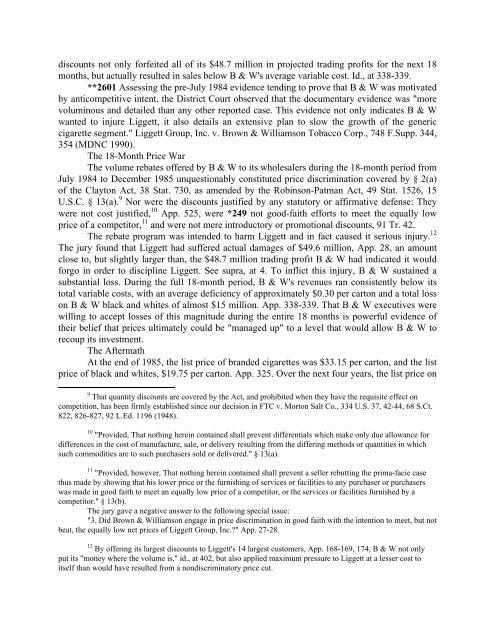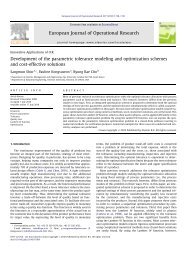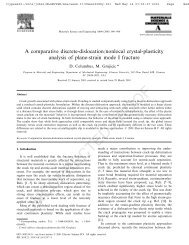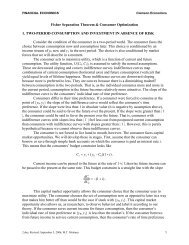509 U.S. 209, 113 S.Ct. 2578 BROOKE GROUP LTD., Petitioner v ...
509 U.S. 209, 113 S.Ct. 2578 BROOKE GROUP LTD., Petitioner v ...
509 U.S. 209, 113 S.Ct. 2578 BROOKE GROUP LTD., Petitioner v ...
Create successful ePaper yourself
Turn your PDF publications into a flip-book with our unique Google optimized e-Paper software.
discounts not only forfeited all of its $48.7 million in projected trading profits for the next 18<br />
months, but actually resulted in sales below B & W's average variable cost. Id., at 338-339.<br />
**2601 Assessing the pre-July 1984 evidence tending to prove that B & W was motivated<br />
by anticompetitive intent, the District Court observed that the documentary evidence was "more<br />
voluminous and detailed than any other reported case. This evidence not only indicates B & W<br />
wanted to injure Liggett, it also details an extensive plan to slow the growth of the generic<br />
cigarette segment." Liggett Group, Inc. v. Brown & Williamson Tobacco Corp., 748 F.Supp. 344,<br />
354 (MDNC 1990).<br />
The 18-Month Price War<br />
The volume rebates offered by B & W to its wholesalers during the 18-month period from<br />
July 1984 to December 1985 unquestionably constituted price discrimination covered by § 2(a)<br />
of the Clayton Act, 38 Stat. 730, as amended by the Robinson-Patman Act, 49 Stat. 1526, 15<br />
U.S.C. § 13(a). 9 Nor were the discounts justified by any statutory or affirmative defense: They<br />
were not cost justified, 10 App. 525, were *249 not good-faith efforts to meet the equally low<br />
price of a competitor, 11 and were not mere introductory or promotional discounts, 91 Tr. 42.<br />
The rebate program was intended to harm Liggett and in fact caused it serious injury. 12<br />
The jury found that Liggett had suffered actual damages of $49.6 million, App. 28, an amount<br />
close to, but slightly larger than, the $48.7 million trading profit B & W had indicated it would<br />
forgo in order to discipline Liggett. See supra, at 4. To inflict this injury, B & W sustained a<br />
substantial loss. During the full 18-month period, B & W's revenues ran consistently below its<br />
total variable costs, with an average deficiency of approximately $0.30 per carton and a total loss<br />
on B & W black and whites of almost $15 million. App. 338-339. That B & W executives were<br />
willing to accept losses of this magnitude during the entire 18 months is powerful evidence of<br />
their belief that prices ultimately could be "managed up" to a level that would allow B & W to<br />
recoup its investment.<br />
The Aftermath<br />
At the end of 1985, the list price of branded cigarettes was $33.15 per carton, and the list<br />
price of black and whites, $19.75 per carton. App. 325. Over the next four years, the list price on<br />
9 That quantity discounts are covered by the Act, and prohibited when they have the requisite effect on<br />
competition, has been firmly established since our decision in FTC v. Morton Salt Co., 334 U.S. 37, 42-44, 68 S.<strong>Ct</strong>.<br />
822, 826-827, 92 L.Ed. 1196 (1948).<br />
10 "Provided, That nothing herein contained shall prevent differentials which make only due allowance for<br />
differences in the cost of manufacture, sale, or delivery resulting from the differing methods or quantities in which<br />
such commodities are to such purchasers sold or delivered." § 13(a).<br />
11 "Provided, however, That nothing herein contained shall prevent a seller rebutting the prima-facie case<br />
thus made by showing that his lower price or the furnishing of services or facilities to any purchaser or purchasers<br />
was made in good faith to meet an equally low price of a competitor, or the services or facilities furnished by a<br />
competitor." § 13(b).<br />
The jury gave a negative answer to the following special issue:<br />
"3. Did Brown & Williamson engage in price discrimination in good faith with the intention to meet, but not<br />
beat, the equally low net prices of Liggett Group, Inc.?" App. 27-28.<br />
12 By offering its largest discounts to Liggett's 14 largest customers, App. 168-169, 174, B & W not only<br />
put its "money where the volume is," id., at 402, but also applied maximum pressure to Liggett at a lesser cost to<br />
itself than would have resulted from a nondiscriminatory price cut.
















